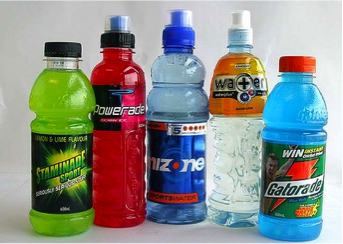The following post is by Jacques Delorme, founder of ViSports at http://visportsnutrition.ca. Jacques is a certified coach with a background in nutrition. He has 30 years of experience in coaching multiple sports to include but not limited to baseball, volleyball and soccer teams of all ages.
Sports drinks have been around since 1965 with the creation of Gatorade by doctors working with the football players at the University of Florida. They are designed to maintain hydration and replace electrolytes and glucose that are lost during exercise. With the loss of about a liter of water per hour through sweat, which contains dissolved salts, athletes need fluids and electrolytes to perform at their best. Losing as little as 2 percent of body weight in the form of sweat can lead to a 10 percent decrease in performance. Electrolytes are needed for nervous system functions as well as muscle contractions. Glucose is the major energy source for muscles during intense exercise. The body stores glucose in the form of glycogen but only has enough for around 90 minutes of exercise. Once used up, blood glucose protein and fiber are used but are less efficient.
Carbs and Electrolytes in Sports Drinks
Glucose is used in sports drinks because it has been found in research to be the most efficient sugar to convert to glycogen. Unfortunately, water absorption in the body can be affected by too much sugar.
Gatorade and Powerade offer 6% and 8% glucose which is the optimum amount for water and carbohydrate absorption. Gatorade’s main source of carbohydrate is sucrose and Powerade uses high fructose corn syrup to provide this glucose percentage.
You will lose 900mg to 1,400mg of sodium in each liter of sweat. As a result, it is the top electrolyte in Powerade and Gatorade. Gatorade contains twice as much as Powerade with 110g per 8 fl. oz. With levels that high, Gatorade may be inappropriate for non-competitive athletes.
Powerade and Gatorade have the same amount of potassium (30mg/8 fl. oz.), which is used in smooth muscle contractions as well as energy production.
Powerade contains magnesium and calcium that Gatorade does not. Loss of magnesium and calcium leads to muscle cramps.
Do You Need Sports Drinks?
With the loss of glycogen and glucose in the body to feed working muscles as well as electrolytes and water from sweat, sports drinks can help with performance but only if the athlete is exercising hard for at least 90 minutes. Powerade has a higher percentage of carbohydrates and a lower level of electrolyte so it may be better for events lasting less than two hours. Gatorade has more sodium and fewer carbs so is better for events lasting more than three hours when extra calories may be taken in from food.
Sports Drink Issue
Research done at the University of Maryland shows that tooth enamel teeth is at risk when exposed to sports beverages like energy drinks and sports drinks as well as fitness water.
Damage to tooth enamel was three to eleven times higher compared to soft drinks. Reason? The acids it contains as additives.
The acids are combining with plaque and demineralizing the surface of the tooth so a cavity can form. The worst offenders were lemonade, sports drinks and energy drinks. To a lesser extent, fitness water, cola and ice tea did the same thing. To avoid the damage simply brush your teeth or drink in gulps every so often instead of sipping which causes the liquid to stay in your mouth too long.
The Newest Danger – BVO
BVO – Brominated Vegetable Oil is an ingredient that is added to beverages to keep ingredients from separating causing oil to rise to the top of the bottle. Bromine is an element that reacts with iodine which can cause issues with the thyroid gland. BVO is found in flame retardant upholstery and pajamas. Strangely enough, we drink it and research is showing that it is building up in people’s bodies including breast milk.
Scientific American has stated that there are apparent “links to impaired neurological development, reduced fertility, early onset of puberty and altered thyroid hormones.”Both PepsiCo and Coke openly use BVO as it is found in Gatorade, Powerade, Fresca, Fanta Orange, Sunkist, and Mountain Dew.
Interestingly enough, BVO has been banned in the European Union and Japan. So really, how valuable an ingredient is it if these products are sold in these countries without it?
Home Recipes
Why buy it when you can make it? You know what you need – 8% sugar (8 grams per 100 mL of water) and 1-2 grams per liter of salt.
Basic Sports Drink
1 liter water (32 oz)
1/3 cup glucose or sucrose
1/4 tsp table salt
Flavoring depending on your taste like orange or lemon juice
Keep refrigerated.
Sports Bottle Drink (20 oz)
3 Tbsp sugar
1/8 tsp table salt
Flavoring like orange or lemon juice, Kool-Aid or other drink mix.
Trying 2-3 Tbsp of juice or 1/3 pack of Kool-Aid.
Keep refrigerated.
Powdered Sports Drink
9 Tbsp sugar
3/8 tspn table salt
1 pack Kool-Aid or other drink mix.
Mix dry.
Split mixture into three ziplock bags.
Add 1 bag to 20-oz. of water in a sports bottle.




Thanks for the article posting Luci! It is always a pleasure to meet other fitness enthusiasts.